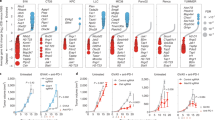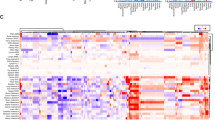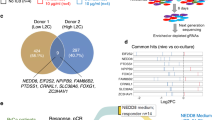Abstract
The clinical successes of immune checkpoint therapies for cancer make it important to identify mechanisms of resistance to anti-tumor immune responses. Numerous resistance mechanisms have been identified employing studies of single genes or pathways, thereby parsing the tumor microenvironment complexity into tractable pieces. However, this limits the potential for novel gene discovery to in vivo immune attack. To address this challenge, we developed an unbiased in vivo genome-wide RNAi screening platform that leverages host immune selection in strains of immune-competent and immunodeficient mice to select for tumor cell-based genes that regulate in vivo sensitivity to immune attack. Utilizing this approach in a syngeneic triple-negative breast cancer (TNBC) model, we identified 709 genes that selectively regulated adaptive anti-tumor immunity and focused on five genes (CD47, TGFβ1, Sgpl1, Tex9 and Pex14) with the greatest impact. We validated the mechanisms that underlie the immune-related effects of expression of these genes in different TNBC lines, as well as tandem synergistic interactions. Furthermore, we demonstrate the impact of different genes with previously unknown immune functions (Tex9 and Pex14) on anti-tumor immunity. Thus, this innovative approach has utility in identifying unknown tumor-specific regulators of immune recognition in multiple settings to reveal novel targets for future immunotherapies.





Similar content being viewed by others
Abbreviations
- BCA:
-
Bicinchoninic acid assay
- CaeCam2:
-
Carcinoembryonic antigen related cell adhesion molecule 2
- CCK:
-
Cholecystokinin
- CCL4:
-
C-C motif chemokine ligand 4
- CO2:
-
Carbon dioxide
- CRISPR:
-
Clustered regularly interspaced short palindromic repeats
- ENPP2:
-
Ectonucleotide pyrophosphatase/phosphodiesterase 2
- FDR:
-
False discovery rate
- GAPDH:
-
Glyceraldehyde 3-phosphate dehydrogenase
- HCL:
-
Hydrogen chloride
- IDO:
-
Indoleamine-pyrrole 2,3 dioxygenase
- IgG:
-
Immunoglobulin G
- IL-4:
-
Interleukin 4
- IL13Ra1:
-
Interleukin 13 receptor subunit alpha 1
- KD:
-
Knocked down
- LIMMA:
-
Linear models for microarray data
- MOI:
-
Multiplicity of infection
- NSG:
-
NOD-SCID-IL2 gamma chain knock-out
- NaCl:
-
Sodium chloride
- OE:
-
Overexpression
- OX40L:
-
Tumor necrosis factor (ligand) superfamily, member 4
- P53:
-
Tumor protein P53
- Pex14:
-
Peroxisomal membrane protein 14
- RNAi:
-
RNA interference
- S1P:
-
Sphingosine-1-phosphate
- SBI:
-
System biosciences
- SEMA7a:
-
Semaphorin 7a
- Sgpl1:
-
Sphingosine-1-phosphate ligase 1
- shRNA:
-
Short harpin RNA
- SMAD3:
-
SMAD family member 3
- Spns2:
-
S1P transporter spinster homologue 2
- Tex9:
-
Testis expressed gene 9
- Tiam1:
-
T-Cell lymphoma invasion and metastasis 1
- TME:
-
Tumor microenvironment
- TNBC:
-
Triple-negative breast cancer
- TSP1:
-
Thrombospondin 1
- WT:
-
Wild-type
References
Wolchok JD, Kluger H, Callahan MK et al (2013) Nivolumab plus Ipilimumab in advanced melanoma. N Engl J Med 369:122–133. doi:10.1056/NEJMoa1302369
Hodi FS, O’Day SJ, McDermott DF et al (2010) Improved survival with ipilimumab in patients with metastatic melanoma. N Engl J Med 363:711–723. doi:10.1056/NEJMoa1003466
Lynch TJ, Bondarenko I, Luft A et al (2012) Ipilimumab in combination with paclitaxel and carboplatin as first-line treatment in stage IIIB/IV non-small-cell lung cancer: results from a randomized, double-blind, multicenter phase II study. J Clin Oncol 30:2046–2054. doi:10.1200/JCO.2011.38.4032
Topalian SL, Hodi FS, Brahmer JR et al (2012) Safety, activity, and immune correlates of anti–PD-1 antibody in cancer. N Engl J Med 366:2443–2454. doi:10.1056/NEJMoa1200690
Porter DL, Levine BL, Kalos M et al (2011) Chimeric antigen receptor-modified T cells in chronic lymphoid leukemia. N Engl J Med 365:725–733. doi:10.1056/NEJMoa1103849
Liedtke C, Mazouni C, Hess KR et al (2008) Response to neoadjuvant therapy and long-term survival in patients with triple-negative breast cancer. J Clin Oncol 26:1275–1281. doi:10.1200/JCO.2007.14.4147
Creelan BC (2014) Update on immune checkpoint inhibitors in lung cancer. Cancer Control 21:80–89
Leto SM, Trusolino L (2014) Primary and acquired resistance to EGFR-targeted therapies in colorectal cancer: impact on future treatment strategies. J Mol Med 92:709–722. doi:10.1007/s00109-014-1161-2
Napolitano S, Martini G, Rinaldi B et al (2015) Primary and acquired resistance of colorectal cancer to anti-EGFR monoclonal antibody can be overcome by combined treatment of regorafenib with cetuximab. Clin Cancer Res 21(13):2975–2983. doi:10.1158/1078-0432.CCR-15-0020
Zahreddine H, Borden KL (2013) Mechanisms and insights into drug resistance in cancer. Front Pharmacol 4:28. doi:10.3389/fphar.2013.00028
Dunn GP, Bruce AT, Ikeda H et al (2002) Cancer immunoediting: from immunosurveillance to tumor escape. Nat Immunol 3:991–998. doi:10.1038/ni1102-991
Driessens G, Kline J, Gajewski TF (2009) Costimulatory and coinhibitory receptors in anti-tumor immunity. Immunol Rev 229:126–144. doi:10.1111/j.1600-065X.2009.00771.x
Pardoll DM (2012) The blockade of immune checkpoints in cancer immunotherapy. Nat Rev Cancer 12:252–264. doi:doi:10.1038/nrc3239
Shuptrine CW, Surana R, Weiner LM (2012) Monoclonal antibodies for the treatment of cancer. Sem Cancer Biol 22:3–13. doi:10.1016/j.semcancer.2011.12.009
Surana R, Wang S, Xu W et al (2014) IL4 limits the efficacy of tumor-targeted antibody therapy in a murine model. Cancer Immunol Res 2:1103–1112. doi:10.1158/2326-6066.CIR-14-0103
Zhou P, Shaffer DR, Alvarez Arias DA et al (2014) In vivo discovery of immunotherapy targets in the tumour microenvironment. Nature 506:52–57. doi:10.1038/nature12988
Zender L, Xue W, Zuber J et al (2008) An oncogenomics-based In Vivo RNAi screen identifies tumor suppressors in liver cancer. Cell 135:852–864. doi:10.1016/j.cell.2008.09.061
Chen S, Sanjana NE, Zheng K et al (2015) Genome-wide CRISPR screen in a mouse model of tumor growth and metastasis. Cell 160:1246–1260. doi:10.1016/j.cell.2015.02.038
Wolf J, Müller-Decker K, Flechtenmacher C et al (2013) An in vivo RNAi screen identifies SALL1 as a tumor suppressor in human breast cancer with a role in CDH1 regulation. Oncogene 33:4273–4278. doi:10.1038/onc.2013.515
Andrysik Z, Kim J, Tan AC, Espinosa JM (2013) A genetic screen identifies TCF3/E2A and TRIAP1 as pathway-specific regulators of the cellular response to p53 activation. Cell Rep 3:1346–1354. doi:10.1016/j.celrep.2013.04.014
Yeung ML, Houzet L, Yedavalli VSRK, Jeang KT (2009) A genome-wide short hairpin RNA screening of jurkat T-cells for human proteins contributing to productive HIV-1 replication. J Biol Chem 284:19463–19473. doi:10.1074/jbc.M109.010033
Hattori H, Zhang X, Jia Y et al (2007) RNAi screen identifies UBE2D3 as a mediator of all-trans retinoic acid-induced cell growth arrest in human acute promyelocytic NB4 cells. Blood 110:640–650. doi:10.1182/blood-2006-11-059048
Berens EB, Sharif GM, Schmidt MO et al (2016) Keratin-associated protein 5-5 controls cytoskeletal function and cancer cell vascular invasion. Oncogene 36:593–605. doi:10.1038/onc.2016.234
Seyhan AA, Varadarajan U, Choe S et al (2012) A genome-wide RNAi screen identifies novel targets of neratinib resistance leading to identification of potential drug resistant genetic markers. Mol BioSyst 8:1553. doi:10.1039/c2mb05512k
Berns K, Horlings HM, Hennessy BT et al (2007) A functional genetic approach identifies the PI3 K pathway as a major determinant of trastuzumab resistance in breast cancer. Cancer Cell 12:395–402. doi:10.1016/j.ccr.2007.08.030
Brummelkamp TR, Fabius AWM, Mullenders J et al (2006) An shRNA barcode screen provides insight into cancer cell vulnerability to MDM2 inhibitors. Nat Chem Biol 2:202–206. doi:10.1038/nchembio774
Smyth GK, Michaud J, Scott HS (2005) Use of within-array replicate spots for assessing differential expression in microarray experiments. Bioinformatics 21:2067–2075. doi:10.1093/bioinformatics/bti270
Du P, Zhang X, Huang C-C et al (2010) Comparison of Beta-value and M-value methods for quantifying methylation levels by microarray analysis. BMC Bioinformatics 11:587. doi:10.1186/1471-2105-11-587
Lin SM, Du P, Huber W, Kibbe WA (2008) Model-based variance-stabilizing transformation for Illumina microarray data. Nucleic Acids Res 36:e11. doi:10.1093/nar/gkm1075
Du P, Kibbe WA, Lin SM (2007) nuID: a universal naming scheme of oligonucleotides for Illumina, Affymetrix, and other microarrays. Biol Direct 2:16. doi:10.1186/1745-6150-2-16
Leek JT, Johnson WE, Parker HS et al (2012) The sva package for removing batch effects and other unwanted variation in high-throughput experiments. Bioinformatics 28:882–883. doi:10.1093/bioinformatics/bts034
Nikitin A, Egorov S, Daraselia N, Mazo I (2003) Pathway studio–the analysis and navigation of molecular networks. Bioinformatics 19:2155–2157. doi:10.1093/bioinformatics/btg290
Sugiura K, Stock CC (1952) Studies in a tumor spectrum. I. Comparison of the action of methylbis(2-chloroethyl)amine and 3-bis(2-chloroethyl)aminomethyl-4-methoxymethyl-5-hydroxy-6-methylpyridine on the growth of a variety of mouse and rat tumors. Cancer 5:382–402. doi:10.1002/1097-0142(195203)5:2<382:AID-CNCR2820050229>3.0.CO;2-3
Sugiura K, Hitchings GH, Cavalieri LF, Stock CC (1950) The effect of 8-azaguanine on the growth of carcinoma, sarcoma, osteogenic sarcoma, lymphosarcoma and melanoma in animals. Cancer Res 10:178–185
Snell GD, Cloudman AM (2016) The effect of rate of freezing on the survival of fourteen transplantable tumors of mice. Cancer Res. http://cancerres.aacrjournals.org/content/canres/3/6/396.full.pdf. Accessed 22 Jul 2016
Johnstone CN, Smith YE, Cao Y et al (2015) Functional and molecular characterisation of EO771.LMB tumours, a new C57BL/6-mouse-derived model of spontaneously metastatic mammary cancer. Dis Model Mech 8:237–251. doi:10.1242/dmm.017830
Purrington KS, Slager S, Eccles D et al (2014) Genome-wide association study identifies 25 known breast cancer susceptibility loci as risk factors for triple-negative breast cancer. Carcinogenesis 35:1012–1019. doi:10.1093/carcin/bgt404
Willingham SB, Volkmer J-P, Gentles AJ et al (2012) The CD47-signal regulatory protein alpha (SIRPa) interaction is a therapeutic target for human solid tumors. Proc Natl Acad Sci USA 109:6662–6667. doi:10.1073/pnas.1121623109
Liu X, Pu Y, Cron K et al (2015) CD47 blockade triggers T cell–mediated destruction of immunogenic tumors. Nat Med 21:1209–1215. doi:10.1038/nm.3931
Massagué J (2008) TGFβ in Cancer. Cell 134:215–230. doi:10.1016/j.cell.2008.07.001
Spiegel S, Milstien S (2011) The outs and the ins of sphingosine-1-phosphate in immunity. Nat Rev Immunol 11:403–415. doi:10.1038/nri2974
Neuzillet C, Tijeras-Raballand A, Cohen R et al (2015) Targeting the TGFβ pathway for cancer therapy. Pharmacol Ther 147:22–31. doi:10.1016/j.pharmthera.2014.11.001
Murphy-Ullrich JE, Poczatek M (2000) Activation of latent TGF-β by thrombospondin-1: mechanisms and physiology. Cytokine Growth Factor Rev 11:59–69. doi:10.1016/S1359-6101(99)00029-5
Shimada K, Nakajima A, Ikeda K et al (2011) CD47 regulates the TGF-β signaling pathway in osteoblasts and is distributed in Meckel’s cartilage. J Oral Sci 53:169–175. doi:10.2334/josnusd.53.169
Rogers NM, Yao M, Novelli EM et al (2012) Activated CD47 regulates multiple vascular and stress responses: implications for acute kidney injury and its management. AJP Renal Physiol 303:F1117–F1125. doi:10.1152/ajprenal.00359.2012
Daniel C, Wiede J, Krutzsch HC et al (2004) Thrombospondin-1 is a major activator of TGF-β in fibrotic renal disease in the rat in vivo. Kidney Int 65:459–468. doi:10.1111/j.1523-1755.2004.00395.x
Tseng D, Volkmer J-P, Willingham SB et al (2013) Anti-CD47 antibody-mediated phagocytosis of cancer by macrophages primes an effective antitumor T-cell response. Proc Natl Acad Sci USA 110(27):11103–11108. doi:10.1073/pnas.1305569110
Kumar A, Saba JD (2009) Lyase to live by: sphingosine phosphate lyase as a therapeutic target. Expert Opin. Ther. Targets 13:1013–1025. doi:10.1517/14728220903039722
Alvarez SE, Milstien S, Spiegel S (2007) Autocrine and paracrine roles of sphingosine-1-phosphate. Trends Endocrinol Metab 18:300–307. doi:10.1016/j.tem.2007.07.005
Weyden LVD, Arends MJ, Campbell AD et al (2017) Genome-wide in vivo screen identifies novel host regulators of metastatic colonization. Nature 541:233–236. doi:10.1038/nature20792
Zhao J, Liu J, Lee J-F et al (2016) TGF-β/SMAD3 pathway stimulates sphingosine-1 phosphate receptor 3 expression. J Biol Chem 291:27343–27353. doi:10.1074/jbc.M116.740084
Radeke HH, von Wenckstern H, Stoidtner K et al (2005) Overlapping signaling pathways of sphingosine 1-phosphate and TGF- in the Murine Langerhans Cell Line XS52. J Immunol 174:2778–2786. doi:10.4049/jimmunol.174.5.2778
Xin C, Ren S, Kleuser B et al (2004) Sphingosine 1-phosphate cross-activates the smad signaling cascade and mimics transforming growth factor-β-induced cell responses. J Biol Chem 279:35255–35262. doi:10.1074/jbc.M312091200
Miller AV, Alvarez SE, Spiegel S, Lebman DA (2008) Sphingosine kinases and sphingosine-1-phosphate are critical for transforming growth factor β-induced extracellular signal-regulated kinase 1 and 2 activation and promotion of migration and invasion of esophageal cancer cells. Mol Cell Biol 28:4142–4151. doi:10.1128/MCB.01465-07
The MGC Project Team (2004) The status, quality, and expansion of the NIH full-length cDNA project: the Mammalian Gene collection (MGC). Genome Res 14:2121–2127. doi:10.1101/gr.2596504
Dammai V, Subramani S (2001) The Human peroxisomal targeting signal receptor, Pex5p, is translocated into the peroxisomal matrix and recycled to the cytosol. Cell 105:187–196. doi:10.1016/S0092-8674(01)00310-5
Albertini M, Rehling P, Erdmann R et al (1997) Pex14p, a peroxisomal membrane protein binding both receptors of the two PTS-dependent import pathways. Cell 89:83–92. doi:10.1016/S0092-8674(00)80185-3
Acknowledgements
This research was supported by the following Shared Resources at Lombardi Comprehensive Cancer Center: The Genomics and Epigenomics Shared Resource, the Flow Cytometry and Cell Sorting Shared Resource, and the Tissue Culture Shared Resource. All Lombardi Comprehensive Cancer Center Shared Resources are partially supported by National Institutes of Health (NIH)/National Cancer Institute (NCI) Grant P30-CA051008. An antibody to CD47 was kindly provided by Dr. Robert Karr, Tioma Therapeutics, Inc (St. Louis, MO).
Author information
Authors and Affiliations
Corresponding author
Ethics declarations
Funding sources
This manuscript was supported by NIH Grants CA50633 (Louis M Weiner) and CA51880 (Louis M Weiner), and Susan G. Komen Career Catalyst Research Grant CCR14299200 (Zachary C Hartman).
Conflict of interest
The authors have no conflicts of interest to report or disclose.
Electronic supplementary material
Below is the link to the electronic supplementary material.
Rights and permissions
About this article
Cite this article
Shuptrine, C.W., Ajina, R., Fertig, E.J. et al. An unbiased in vivo functional genomics screening approach in mice identifies novel tumor cell-based regulators of immune rejection. Cancer Immunol Immunother 66, 1529–1544 (2017). https://doi.org/10.1007/s00262-017-2047-2
Received:
Accepted:
Published:
Issue Date:
DOI: https://doi.org/10.1007/s00262-017-2047-2




